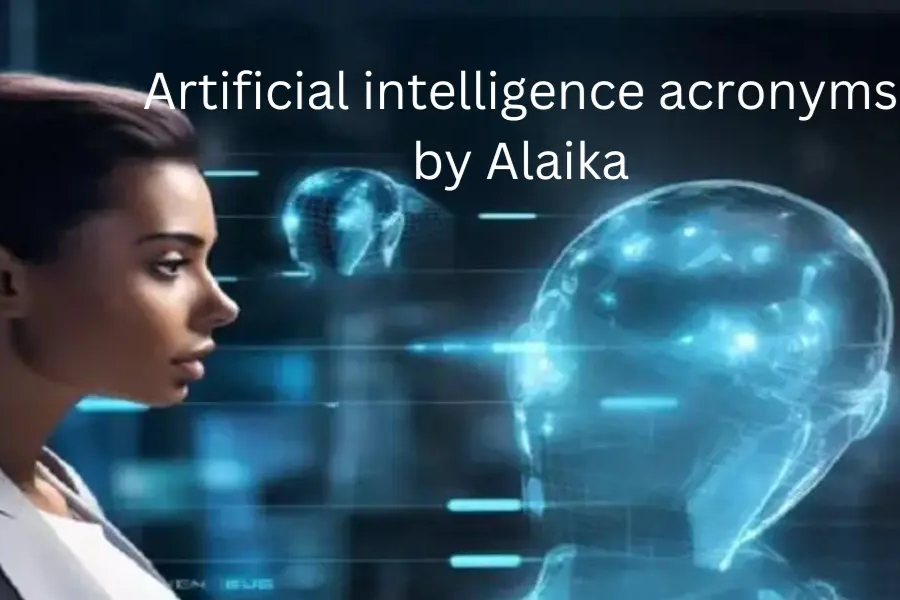Introduction
Artificial Intelligence (AI) and machine learning are no longer mere buzzwords; they are fundamental to the transformation occurring across various industries. These technologies drive everything from healthcare advancements to financial innovations and autonomous vehicles. In this landscape, AI acronyms by Alaikas play a significant role in simplifying complex concepts and fostering effective communication among professionals. This comprehensive guide explores what these acronyms are, their benefits, challenges, and their impact on the future of AI and machine learning.
AI and Machine Learning: The Backbone of Modern Tech
Artificial Intelligence (AI) and machine learning have become indispensable in today’s technological ecosystem.
Understanding AI
AI refers to systems designed to perform tasks that typically require human intelligence. These duties involve making decisions, identifying patterns, and solving problems. AI falls into a number of categories, including:
- Narrow AI: Specializes in one task (e.g., voice assistants like Siri).
- General AI: Possesses human-like cognitive abilities (still theoretical).
- Superintelligent AI: Surpasses human intelligence (conceptual).
The Role of Machine Learning
Within the field of artificial intelligence, machine learning is the study of how machines may learn from data and gradually enhance their performance without the need for explicit programming. Machine learning includes a number of methods:
- Supervised Learning: Models are trained using labeled data.
- Unsupervised Learning: Models identify patterns in unlabeled data.
- Reinforcement Learning: Models learn by receiving rewards or penalties for actions.
Recent Advancements in AI and Machine Learning
The rapid advancements in AI and machine learning have led to groundbreaking innovations across various sectors.
Healthcare Innovations
AI’s impact on healthcare is transformative. AI algorithms analyze vast amounts of medical data to predict diseases, personalize treatment plans, and improve diagnostic accuracy. For example:
- Disease Prediction: AI systems predict conditions like cancer through pattern recognition in medical images and genetic data.
- Personalized Treatment: Machine learning models tailor treatments based on individual patient data, improving outcomes and reducing side effects.
Financial Sector Transformations
The financial industry benefits significantly from AI technologies:
- Fraud Detection: To identify fraudulent activity, machine learning algorithms examine transaction patterns.
- Customer Service: AI chatbots provide instant support, handling queries and transactions efficiently.
Autonomous Vehicles
Self-driving technology, spearheaded by companies like Tesla and Waymo, utilizes AI to develop vehicles capable of navigating without human input. This innovation aims to:
- Reduce Accidents: AI systems improve safety by minimizing human error.
- Enhance Efficiency: Autonomous vehicles optimize routes and traffic management.
The Future of AI and Machine Learning
Artificial Intelligence and machine learning have enormous possibilities in the future.
- Smart Cities: AI will enhance urban infrastructure, optimizing traffic, energy consumption, and public safety.
- Advanced Robotics: Robotics powered by AI will perform complex tasks, from manufacturing to healthcare.
What Are Artificial Intelligence Acronyms by Alaikas?
Understanding AI Acronyms by Alaikas
Artificial intelligence acronyms by Alaikas are specialized terms and abbreviations designed to simplify and communicate complex AI concepts. Alaikas, a leader in AI research, has developed a comprehensive set of acronyms that are widely adopted within the industry. These acronyms serve as a universal language, making it easier for professionals to discuss and implement AI technologies.
Examples of AI Acronyms by Alaikas
Several acronyms by Alaikas are pivotal in various AI applications:
NLP (Natural Language Processing)
NLP is a subfield of artificial intelligence that studies how human languages and computers interact. Important uses for NLP include:
- Translation of text between languages using machine translation.
- Sentiment Analysis: Determining the emotional tone of a text.
- Voice Recognition: Converting spoken language into text.
Alaikas has significantly advanced NLP algorithms, enhancing their accuracy and efficiency in processing natural language.
CNN (Convolutional Neural Network)
CNNs are deep learning algorithms specifically designed for processing grid-like data, such as images. Their applications include:
- Image Recognition: Identifying objects within images.
- Video Analysis: Analyzing video frames for object detection and tracking.
Alaikas’s work on CNNs has led to improved accuracy in visual data interpretation, benefiting industries like security and media.
RPA (Robotic Process Automation)
Software robots are used in RPA to automate repetitive operations. It is frequently utilized for:
- Streamline Operations: Automate routine tasks, such as data entry and report generation.
- Increase Efficiency: Reduce the need for manual intervention in business processes.
Alaikas’s RPA solutions are pivotal in enhancing operational efficiency across various sectors.
How AI Acronyms by Alaikas Are Utilized
Alaikas integrates these acronyms into a wide range of AI applications:
- NLP in Chatbots: Enhances customer service by enabling natural language interactions.
- CNN in Security Systems: Used for facial recognition and surveillance.
- RPA in Administrative Tasks: Automates tasks like data processing and customer onboarding.
These applications demonstrate how AI acronyms by Alaikas contribute to practical, real-world solutions.
References and Real-World Applications
Many leading technology companies utilize AI acronyms developed by Alaikas:
- Google: Uses NLP for its search algorithms, improving search accuracy and relevance.
- Amazon: Employs CNNs in its product recommendation systems, enhancing user experience.
- Banks: Implement RPA to automate routine transactions, increasing operational efficiency.
These examples highlight the widespread adoption and significance of AI acronyms in driving technological progress.
Pros and Cons of Artificial Intelligence Acronyms by Alaikas
Pros
Simplifies Complex Concepts
AI acronyms by Alaikas make intricate AI concepts more accessible. By breaking down complex terms into manageable pieces, these acronyms facilitate understanding and communication.
Enhances Communication
Standardized acronyms improve communication among AI professionals, ensuring clarity and reducing misunderstandings. This standardization is crucial for collaborative projects and interdisciplinary work.
Promotes Efficiency
These acronyms expedite the learning process for newcomers in AI. They offer a quick reference for understanding various AI components, enabling faster comprehension and application.
Cons
Can Be Overwhelming
For beginners, the sheer volume of acronyms can be intimidating. Learning and retaining a large number of terms requires time and effort.
Potential for Miscommunication
Acronyms can lead to confusion if not properly defined. Different organizations or contexts may use the same acronym for different terms, causing potential misunderstandings.
May Oversimplify
While acronyms simplify concepts, they can also lead to oversimplification. This reductionism might obscure the underlying principles and complexities of AI technologies.
Progress Report of Artificial Intelligence Acronyms by Alaikas
Yearly Milestones
- 2018: Initial Development
Alaikas initiated the development of AI acronyms to simplify AI terminology, aiming to create a standardized language for the industry. - 2019: Industry Adoption
Major tech companies began incorporating Alaikas’s AI acronyms into their operations, recognizing their utility in streamlining communication and processes. - 2020: Enhanced Algorithms
Advancements in NLP, CNN, and RPA algorithms were introduced, leading to improved accuracy and efficiency in AI applications. - 2021: Expanded Applications
AI acronyms were integrated into new fields, including healthcare and finance, demonstrating their versatility and impact. - 2022: Global Recognition
Alaikas’s AI acronyms gained global recognition, becoming a standardized part of the AI industry’s lexicon. - 2023: Continuous Improvement
Ongoing refinements to existing acronyms and the development of new ones reflect the dynamic nature of AI research and application.
Conclusion
Artificial intelligence acronyms by Alaikas play a crucial role in the AI industry. They simplify complex concepts, enhance communication, and promote efficiency. While there are challenges associated with their use, such as the potential for overwhelming beginners and oversimplifying concepts, the benefits are substantial. As AI technology continues to advance, these acronyms will remain integral to the field, facilitating better understanding and driving innovation. By embracing and utilizing these acronyms, professionals and enthusiasts can navigate the evolving landscape of artificial intelligence with greater ease.
FAQs
What are AI acronyms by Alaikas?
AI acronyms by Alaikas are standardized terms and abbreviations used to simplify and communicate complex AI concepts.
Why are these acronyms important?
They make understanding and communicating AI concepts more accessible, facilitating clearer discussions and faster learning.
Can beginners use these acronyms?
Yes, these acronyms are designed to help beginners grasp complex AI terms quickly and efficiently.
Are these acronyms widely recognized?
Yes, they are adopted by major tech companies and recognized globally, highlighting their significance in the AI industry.
How do these acronyms enhance efficiency?
They provide a quick reference for understanding various AI components, speeding up the learning process and application.
What are some common AI acronyms by Alaikas?
Examples include NLP (Natural Language Processing), CNN (Convolutional Neural Network), and RPA (Robotic Process Automation).
Are there any drawbacks to using these acronyms?
They can be overwhelming for beginners and may lead to oversimplification of complex concepts.
How does Alaikas ensure the accuracy of these acronyms?
Alaikas continuously updates and refines its acronyms based on the latest research and industry feedback, ensuring their relevance and accuracy.




Leave a Reply